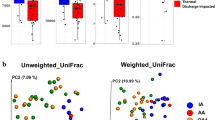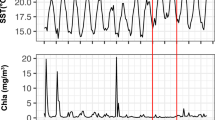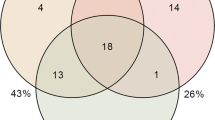Abstract
The long-term effects of ocean warming on prokaryotic communities are unknown because of lack of historical data. We overcame this gap by applying a retrospective molecular analysis to the bacterial community on formalin-fixed samples from the historical Continuous Plankton Recorder archive, which is one of the longest and most geographically extensive collections of marine biological samples in the world. We showed that during the last half century, ubiquitous marine bacteria of the Vibrio genus, including Vibrio cholerae, increased in dominance within the plankton-associated bacterial community of the North Sea, where an unprecedented increase in bathing infections related to these bacteria was recently reported. Among environmental variables, increased sea surface temperature explained 45% of the variance in Vibrio data, supporting the view that ocean warming is favouring the spread of vibrios and may be the cause of the globally increasing trend in their associated diseases.
Similar content being viewed by others
Log in or create a free account to read this content
Gain free access to this article, as well as selected content from this journal and more on nature.com
or
Accession codes
References
Acinas SG, Marcelino LA, Klepac-Ceraj V, Polz MF . (2004). Divergence and redundancy of 16S rRNA sequences in genomes with multiple rrn operons. J Bacteriol 186: 2629–2635.
Anderson MJ . (2003). DISTLM Forward: A FORTRAN Computer Program to Calculate a Distance-Based Multivariate Analysis for a Linear Model Using Forward Selection. Department of Statistics, University of Auckland: New Zealand.
Andersen PH . (2006). Infections with seawater bacteria. EPI-NEWS 1: 26–32.
Andersson Y, Ekdahl K . (2006). Wound infections due to Vibrio cholerae in Sweden after swimming in the Baltic Sea, summer 2006. Euro Surveill 11: E060803.2.
Austin B . (2005). Bacteria pathogens of marine fish. In: Belkin S, Colwell RR (eds). Ocean and Health Pathogens in the Marine Environment. Springer-Verlag: New York, pp 391–413.
Batten SD, Clark R, Flinkman J, Hays GC, John E, John AWG et al. (2003). CPR sampling: the technical background, materials and methods, consistency and comparability. Prog Oceanogr 58: 193–215.
Colwell RR . (1996). Global climate and infectious disease: the cholera paradigm. Science 274: 2031–2025.
De Giorgi C, Finetti Sialer M, Lamberti F . (1994). Formalin-induced infidelity in PCR-amplified DNA fragments. Mol Cell Probes 8: 459–462.
DeLong EF . (1996). Diversity of naturally occurring prokaryotes. In: Colwell RR, Simidu U, Ohwada K (eds). Microbial Diversity in Time and Space. Plenum Press: New York, pp 125–132.
Edwards M, Richardson AJ . (2004). Impact of climate change on marine pelagic phenology and trophic mismatch. Nature 430: 881–884.
Frank C, Littman M, Alpers K, Hallauer J . (2006). Vibrio vulnificus wound infections after contact with the Baltic Sea, Germany. Euro Surveill 11: E060817.1.
Harvell CD, Mitchell CE, Ward JR, Altizer S, Dobson AP, Ostfeld RS et al. (2002). Climate warming and disease risks for terrestrial and marine biota. Science 296: 2158–2162.
Huq A, West PA, Small EB, Huq MI, Colwell RR . (1984). Influence of water temperature, salinity, and Ph on survival and growth of toxigenic Vibrio cholerae serovar O1 associated with live copepods in laboratory microcosms. Appl Environ Microbiol 48: 420–424.
Huson DH, Auch AF, Qi J, Schuster SC . (2007). MEGAN analysis of metagenomic data. Genome Res 17: 377–386.
Kaper JB, Morris JGJ, Levine MM . (1995). Cholera. Clin Microbiol Rev 8: 48–86.
Kirby RR, Reid PC . (2001). PCR from the CPR offers a historical perspective on marine population ecology. J Mar Biol Assoc UK 81: 539–540.
Kirby RR, Beaugrand G, Lindley JA, Richardson AJ, Edwards M, Reid PC . (2007). Climate effects and benthic–pelagic coupling in the North Sea. Mar Ecol Prog Ser 330: 31–38.
Kormas KA . (2011). Interpreting diversity of Proteobacteria based on 16S rRNA gene copy number. In: Sezenna ML (ed.). Proteobacteria: Phylogeny, Metabolic Diversity and Ecological Effects. Nova Publishers, Hauppauge: New York, pp 73–89.
Levin RE . (2006). Vibrio parahaemolyticus, a notably lethal human pathogen derived from seafood: a review of its pathogenicity, characteristics, subspecies characterization, and molecular methods of detection. Food Biotechnol 20: 93–128.
Marine Climate Change Impacts Partnership (2010). Marine climate change impacts annual report card 2010–2011. In: Baxter JM, Buckley PJ, Wallace CJ (eds). Summary Report. MCCIP: Lowestoft. Downloadable from http://www.mccip.org.uk/arc.
Martinez-Urtaza J, Bowers JC, Trinanes J, DePaola A . (2010). Climate anomalies and the increasing risk of Vibrio parahaemolyticus and Vibrio vulnificus illnesses. Food Res Int 43: 1780–1790.
Mitra S, Klar B, Huson DH . (2009). Visual and statistical comparison of metagenomes. Genome Anal 25: 1849–1855.
Paillard C, Le Roux F, Borreg JJ . (2004). Bacterial disease in marine bivalves, a review of recent studies: trends and evolution. Aquat Living Resour 17: 477–498.
Pascual M, Rodó X, Ellner SP, Colwell RR, Bouma MJ . (2000). Cholera dynamics and El Niño-Southern oscillation. Science 289: 1766–1769.
Pruzzo C, Huq A, Colwell RR, Donelli G . (2005). Pathogenic Vibrio species in the marine and estuarine environment. In: Belkin S, Colwell RR (eds). Ocean and Health Pathogens in the Marine Environment. Springer-Verlag: New York, pp 217–252.
Raffaelli DG . (2004). How extinction patterns affect ecosystems. Science 306: 1141–1142.
Rayner NA, Brohan P, Parker DE, Folland CK, Kennedy JJ, Vanicek M . (2006). Improved analyses of changes and uncertainties in sea surface temperature measured in situ since the mid-nineteenth century: the HadSST2 data set. J Climate 19: 446–469.
Reid PC, Borges MD, Svendsen EA . (2001). Regime shift in the North Sea circa 1988 linked to changes in the North Sea fishery. Fish Res 50: 163–171.
Reid PC, Colebrook JM, Matthews JBL, Aiken J . (2003). The Continuous Plankton Recorder: concepts and history, from Plankton Indicator to undulating recorders. Prog Oceanogr 58: 117–173.
Ripley SJ, Baker AC, Miller PI, Walne AW, Schroeder DC . (2008). Development and validation of a molecular technique for the analysis of archived formalin-preserved phytoplankton samples permits retrospective assessment of Emiliania huxleyi communities. J Microbiol Meth 73: 118–124.
Sala E, Knowlton N . (2006). Global marine biodiversity trends. Annu Rev Env Resour 31: 93–122.
Sarmento H, Montoya JM, Vazquez-Dominguez E, Vaque D, Gasol JM . (2010). Warming effects on marine microbial food web processes: how far can we go when it comes to predictions? Philos Trans R Soc B 365: 2137–2149.
Schets FM, Van den Berg HHJL, Demeulmeester AA, Van Dijk E, Rutjes SA, Van Hooijdonk HJP et al. (2006). Vibrio alginolyticus infections in the Netherlands after swimming in the North Sea. Euro Surveill 11: E061109.3.
Shapiro RL, Altekruse S, Hutwagner L, Bishop R, Hammond R, Wilson S et al. (1998). The role of Gulf Coast oysters harvested in warmer months in Vibrio vulnificus infections in the United States, 1988–1996. J Infect Dis 178: 752–759.
Sogin ML, Morrison HG, Huber JA, Mark Welch D, Huse SM, Neal PR . (2006). Microbial diversity in the deep sea and the underexplored ‘rare biosphere’. Proc Natl Acad Sci USA 103: 12115–12120.
Stauder M, Vezzulli L, Pezzati E, Repetto B, Pruzzo C . (2010). Temperature affects Vibrio cholerae O1 El Tor persistence in the aquatic environment via an enhanced expression of GbpA and MSHA adhesins. Environ Microbiol Rep 2: 140–144.
Thompson JR, Randa MA, Marcelino LA, Tomita-Mitchell A, Lim E, Polz MF . (2004). Diversity and dynamics of a North Atlantic coastal Vibrio community. Appl Environ Microbiol 70: 4103–4110.
Turner JW, Good B, Cole D, Lipp EK . (2009). Plankton composition and environmental factors contribute to Vibrio seasonality. ISME J 3: 1082–1092.
Venter JC, Remington K, Heidelberg JF, Halpern AL, Rusch D, Eisen JA et al. (2004). Environmental genome shotgun sequencing of the Sargasso Sea. Science 304: 66–74.
Vezzulli L, Dowland PS, Reid PC, Hylton EK . (2007). Gridded Database Browser of North Sea Plankton, Version 1.1: Fifty Four Years (1948–2001) of Monthly Plankton Abundance from the Continuous Plankton Recorder (CPR) Survey. Sir Alister Hardy Foundation: Plymouth, UK, http://cpr.cscan.org/.
Vezzulli L, Previati M, Pruzzo C, Marchese A, Bourne DG, Cerrano C . (2010). Vibrio infections triggering mass mortality events in a warming Mediterranean Sea. Environ Microbiol 12: 2007–2019.
Vezzulli L, Pezzati E, Moreno M, Fabiano M, Pane L, Pruzzo C . (2009). Benthic ecology of Vibrio spp. and pathogenic Vibrio species in a coastal Mediterranean environment (La Spezia Gulf, Italy). Microb Ecol 58: 808–818.
Vezzulli L, Reid PC . (2003). The CPR survey (1948–1997): a gridded database browser of plankton abundance in the North Sea. Progr Oceanogr 58: 327–336.
Voigt W, Perner J, Davis AJ, Eggers T, Schumacher J, Bahrmann R et al. (2003). Trophic levels are differentially sensitive to climate. Ecology 84: 2444–2453.
Acknowledgements
We thank all past and present members and supporters of the CPR survey whose efforts have enabled the establishment and long-term maintenance of the CPR data set and the archived samples used in this study. We also acknowledge the voluntary contribution of the owners, masters and crews of the ships that tow the CPRs without whose help the survey would not be possible. The Sir Alister Hardy Foundation for Ocean Science currently operates the CPR survey. Support of the National Institutes of Health (Grant no. 2RO1A1039129-11A2-NIH) and National Oceanic and Atmospheric Administration, Oceans and Human Health Initiative (Grant no. S0660009) is gratefully acknowledged. This work was also supported by the Ministero dell’Università e della Ricerca Scientifica e Tecnologica (PRIN) and by grants from Genoa University.
Author contributions
LV, CP, IB, MGH, PR and RC designed the research; LV, IB and EP performed the research; LV, CP, EP, IB, MGH and RC analysed the data; and LV and CP wrote the paper.
Author information
Authors and Affiliations
Corresponding author
Additional information
Supplementary Information accompanies the paper on The ISME Journal website
Rights and permissions
About this article
Cite this article
Vezzulli, L., Brettar, I., Pezzati, E. et al. Long-term effects of ocean warming on the prokaryotic community: evidence from the vibrios. ISME J 6, 21–30 (2012). https://doi.org/10.1038/ismej.2011.89
Received:
Revised:
Accepted:
Published:
Issue date:
DOI: https://doi.org/10.1038/ismej.2011.89
Keywords
This article is cited by
-
Distinct coral environments shape the dynamic of planktonic Vibrio spp.
Environmental Microbiome (2023)
-
The impacts of ocean acidification, warming and their interactive effects on coral prokaryotic symbionts
Environmental Microbiome (2023)
-
Combating cholera by building predictive capabilities for pathogenic Vibrio cholerae in Yemen
Scientific Reports (2023)
-
Vibrio cholerae—An emerging pathogen in Austrian bathing waters?
Wiener klinische Wochenschrift (2023)
-
Invasive slipper limpets (Crepidula fornicata) act like a sink, rather than source, of Vibrio spp.
Biological Invasions (2022)



